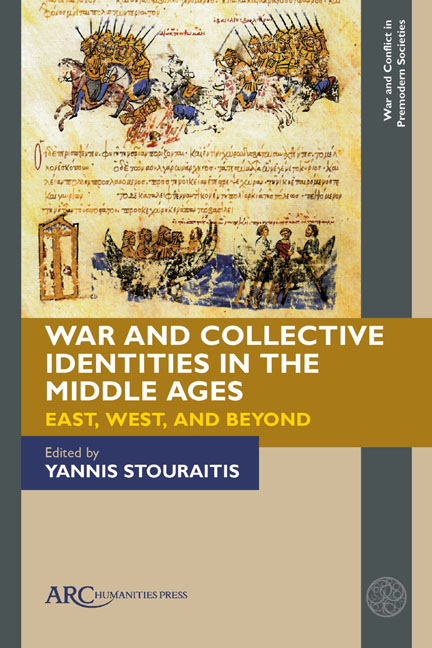Book contents
- Frontmatter
- Contents
- Notes on Contributors
- Chapter 1 War and Peoplehood in the Middle Ages: An Introduction
- Chapter 2 War and Peoplehood through Time: A Sociological Longue Durée Perspective
- Chapter 3 Making War Ethnic: Arab– Persian Identities and Conflict on the Euphrates Frontier
- Chapter 4 Captive Identities: Inscribing Armenianness from Sebēos to Ayrivanec‘i
- Chapter 5 War and Identity in Early Medieval Bulgaria
- Chapter 6 Collective Identifications in Byzantine Civil Wars
- Chapter 7 Warfare and Peoplehood: The Vikings and the English
- Chapter 8 Medieval European Civil Wars: Local and Proto-national Identities of Toulousains, Parisians, and Prague Czechs
- Chapter 9 The Crusades and French Political Identity in the Thirteenth-Century Mediterranean
- Chapter 10 The Song– Jurchen Conflict in Chinese Intellectual History
- Chapter 11 Faithful to a Vanishing Past: Narrating Warfare and Peoplehood in Yuan China
- Chapter 12 War and Collective Identifications in Medieval Societies: Drawing Comparisons
- Selected Bibliography
- Index
Chapter 4 - Captive Identities: Inscribing Armenianness from Sebēos to Ayrivanec‘i
Published online by Cambridge University Press: 28 December 2023
- Frontmatter
- Contents
- Notes on Contributors
- Chapter 1 War and Peoplehood in the Middle Ages: An Introduction
- Chapter 2 War and Peoplehood through Time: A Sociological Longue Durée Perspective
- Chapter 3 Making War Ethnic: Arab– Persian Identities and Conflict on the Euphrates Frontier
- Chapter 4 Captive Identities: Inscribing Armenianness from Sebēos to Ayrivanec‘i
- Chapter 5 War and Identity in Early Medieval Bulgaria
- Chapter 6 Collective Identifications in Byzantine Civil Wars
- Chapter 7 Warfare and Peoplehood: The Vikings and the English
- Chapter 8 Medieval European Civil Wars: Local and Proto-national Identities of Toulousains, Parisians, and Prague Czechs
- Chapter 9 The Crusades and French Political Identity in the Thirteenth-Century Mediterranean
- Chapter 10 The Song– Jurchen Conflict in Chinese Intellectual History
- Chapter 11 Faithful to a Vanishing Past: Narrating Warfare and Peoplehood in Yuan China
- Chapter 12 War and Collective Identifications in Medieval Societies: Drawing Comparisons
- Selected Bibliography
- Index
Summary
IN CA. 600 CE the Sasanian Shah Ḵosrow II (r. 590– 628) appointed the Armenian nobleman Smbat Bagratuni marzpan (marzbān) or governor of the province of Vrkan (Gorgān/Hyrcania) to the east of the Caspian Sea as a reward for his successful military suppression of revolts in the empire. Upon his arrival in Vrkan, Smbat came across a colony of captives who had been deported from their native lands at some point in the past to the edge of the desert that stretched from Turkistan to Dehestān. The colony consisted of peoples captured from Armenia, the Byzantine Empire, and Syria, and included Christians as well as “infidels,” possibly adherents of some form of Zoroastrianism or northern Mesopotamian Semitic cult. The episode is first recorded in Armenian historiography in the seventh-century History of Armenia attributed to Sebēos, who focuses on the captives from Armenia. He recounts that the captives had lost their language, literacy, and religious hierarchy, but he does not explain what identified them as “Armenian,” given that these people had lost the ability to speak, read, and write Armenian, and did not have a priest. Nonetheless, they were subsequently “confirmed in the faith,” taught to speak and become literate in Armenian, and had one of their elders, a certain Abēl, appointed as priest for their community.
The story was subsequently repeated in historiographical works up through the thirteenth century. The passage is particularly suggestive because the notion of “lost Armenians” opened a space for the narrators who retold it to inscribe their own ideology of what constituted “Armenianness” and who had the authority and legitimacy to confer that identity. In other words, the story persisted as a lieu de mémoire, a literary site whose conscious remembering provided an opportunity for each author to stake claims to “Armenianness.” This process of remembering did not comprise the mere repetition of information, but entailed strategies of unremembering, addition, and alteration. Beginning with a close reading of this passage in Sebēos, this chapter interrogates from a mnemohistorical perspective how later narrators modulated the story.
- Type
- Chapter
- Information
- War and Collective Identities in the Middle AgesEast, West, and Beyond, pp. 65 - 86Publisher: Amsterdam University PressPrint publication year: 2023



